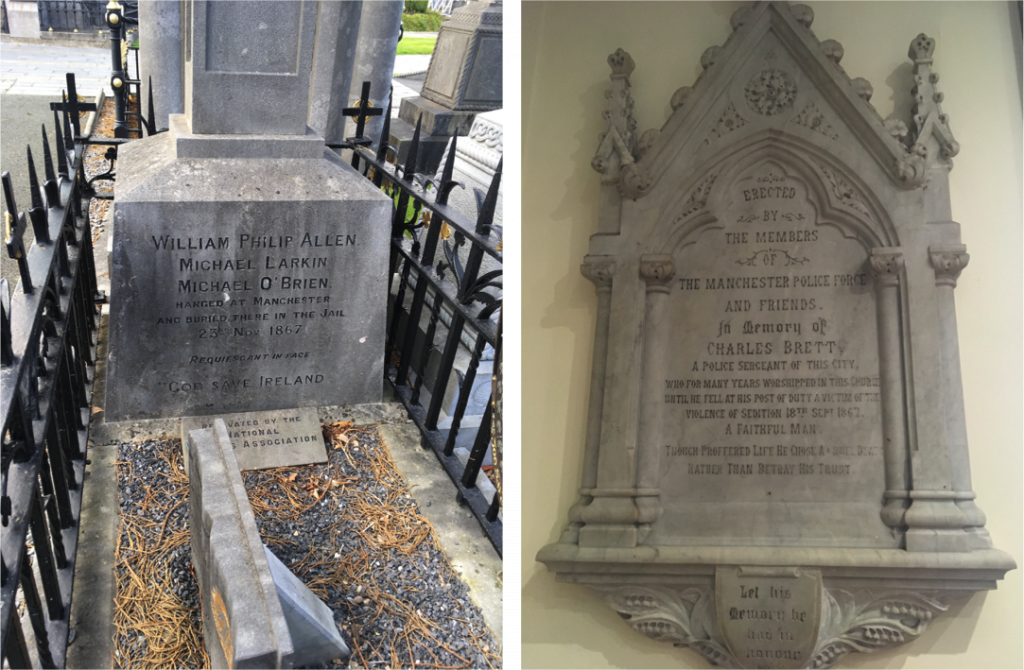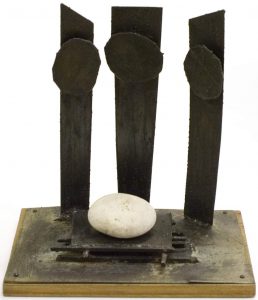
On 23 November 1867 three dubiously convicted young Irishmen were hanged outside the New Bailey Prison in Salford, just across the River Irwell from where the People’s History Museum is today. PhD historian at UCL and head writer for our friends at the Radical Tea Towel Company, Peter Morgan, tells the turbulent tale of the Manchester Martyrs and looks thoughtfully forward to the museum’s 2020 theme of migration.
William Allen, Michael Larkin, and Michael O’Brien were executed on 23 November 1867 for the murder of Sergeant Charles Brett and hanged outside the New Bailey Prison in Salford. They were the first Irishmen executed for a political crime by the British state since the Republican rebel, Robert Emmet, in 1803 and a crowd of thousands, many from the local Irish community and sympathetic to the Republican cause, attended. Fenian propagandists rapidly transformed the three dead men into the ‘Manchester Martyrs’, which brought many Irish into the Fenian movement as active members, and thousands more as newly sympathetic supporters.
In Victorian Ireland there was a real, popular sense of mistreatment, ripe for agitation. And it was to seize this political opportunity that, in 1858, the Irish Republican Brotherhood had come into being. Founded in the US and soon known as just ‘the Fenians’, this Brotherhood called for an Irish republic independent of Britain, to be achieved by armed force.
Despite condemnation by the Catholic Church (more from fear of losing its political dominance of Ireland than out of a principled objection to violence), the Fenians quickly grew in popularity. Appealing to a popular mythology of armed struggle against the English crown which they cleverly situated in contemporary grievances with British rule, the Fenians soon had a network of cells across Ireland and, crucially, the Irish diaspora.
Ireland was uneasy in the 1860s. The Great Famine – for which most, with justification, blamed the fatal non-intervention of the British government – was still a hulking shadow over Irish hearts and memories. Moreover, the multiplying Irish voices for Home Rule as a solution to this sort of governmental neglect were met with political hostility and derision from the English elites.
Manchester’s story has long been tied to Ireland’s. For two centuries and more, since the city began its transformation into an industrial metropolis, the Irish have come – and kept coming – in search of work and a better life for their families, enriching Mancunian cultural and social life in the process (we’d have no Gallagher brothers – so no Oasis – without the Manchester Irish!).
By 1861, Irish born citizens made up 15.2% of the Manchester population, concentrated in areas like Ancoats and Angel Meadows. Near Hulme, there was a slum going by the name of ‘Little Ireland’ due to the sheer number of its residents who had come to Manchester from across the Irish Sea.
Manchester was on the frontline between Irish nationalists and the British state in the 1860s. Fenianism walked onto fertile political ground in cities like Manchester. Here, the Irish – many of whom were recent refugees from the Great Famine – had their various national grievances compounded by the biting alienation and poverty which characterised working class life in Victorian cities. Fenian talk of solidarity and liberation spoke to a need in their bitterly exploited lives.
So, when two high profile Irish American Fenian leaders, Thomas J Kelly and Timothy Deasy, were arrested in Manchester on 11 September 1867, the Fenian Brotherhood found a flock of Mancunian volunteers eager to help rescue them from police custody.
The city was about to become a dangerous battleground in the fight between Irish republicanism and the English crown…
On 18 September 1867, Thomas J Kelly and Timothy Deasy were being transported to Belle Vue Prison in Manchester. When their police convoy was driving down Hyde Road, it was ambushed by no fewer than 40 armed Fenians.
The Irish were there to rescue their two commanders and they were under orders that none of the policemen should be harmed.
All initially went according to their plan; the police surrendered or fled and the Fenians established control of the road. But then, unable to gain access to the van holding Kelly and Deasy with crowbars, they shot the lock off the van, accidentally killing the policeman sat with them inside, Sergeant Charles Brett.
Shocked by the audacity of the Fenians to act so openly in England itself, and using the death of Sergeant Brett as capital, an enraged British establishment cried out for Irish blood. Writing on the Fenian raid, the conservative press announced, ‘one of the most audacious outrages that have occurred in this country for many years.’[1] The Times newspaper made ominous calls for a ‘stern and decisive repression,’ preaching that, ‘there is but one way of meeting unlawful terrorism. It must be repelled by lawful terrorism.’[2]
With the viscerally anti-Irish Tories in power at the time, these hardliners got the response they wanted. Heavy handed and barely discriminate police raids of the Irish districts in Manchester produced 29 arrests. After a quick and procedurally dubious trial process, five of these men were convicted of the murder of Sergeant Brett and condemned to death by hanging.
After one of them (Thomas Maguire ) was reprieved, and another (Edward Condon) had his sentence commuted after the intervention of the US government (he was an American citizen who had fought for the Union in the Civil War), three Irishmen were left to hang – publicly – at the New Bailey Prison in Salford, shortly after 8.00am on 23 November 1867.
The Manchester Martyrs were buried within the walls of the New Bailey Prison and also quickly given a shared tombstone in the hallowed grounds of Glasnevin (Ireland’s national cemetery) by their Irish admirers; mock funeral processions (including one made up of 60,000 people in Dublin, and two in Manchester itself) followed as well as a song composed to mark their death (God Save Ireland – named for the closing words of Edward Condon’s trial speech), which became the de facto Irish national anthem.
There is a memorial to Police Sergeant Charles Brett at the western end of St Ann’s Church in central Manchester.

For the journalists and politicians who had demanded them, the executions of Allen, Larkin, and O’Brien were a just punishment for a criminal act, but for millions of Irish people across the world they were glorified murder. It renewed and deepened Irish fury against the British state. So long as Fenianism, with its separatist republican project, was the only movement offering a transformed future to Irish people under famine at home and proletarianisation across the industrial diaspora, then every attempt to repress it would be futile.
The tale of the Manchester Martyrs is well worth the reflection of anyone interested in the histories of Manchester and Ireland, and of anyone committed to a politics of reconciliation, understanding, and progress for the British Isles today.’
Peter Morgan PhD historian at UCL and head writer at the Radical Tea Towel Company.

Our friends at Salford’s Working Class Movement Library (WCML) hold material on the Manchester Martyrs, including early pamphlets, late 20th century material about the commemorations, a letter written by William Allen to his mother dated 27 October 1867 from New Bailey Prison and a copy of the letter from Michael O’Brien to his brother dated 14 November 1867. You can also read more about the Manchester Martyrs sculpture that was never made in this blog The Manchester Martyrs maquette.
Once a sprawling jail housing nearly 1,000 inmates, New Bailey Prison closed in 1868. Where it stood has now been built upon and replaced with a brand new riverside development.
[1] The Annual Register: A Review of Public Events at Home and Abroad for the Year 1867, (London, 1868), part 2, “Chronicle of Remarkable Occurrences”, pp. 131-34
[2] The Times, October 8, 1867, p. 6
Guest blogs are not curated by PHM but feature voices on topics relevant to the museum’s collection. Guest blogs do not necessarily reflect the views of PHM. Photographs supplied by contributor.
An earlier version of this blog was first published on 22 November 2019.